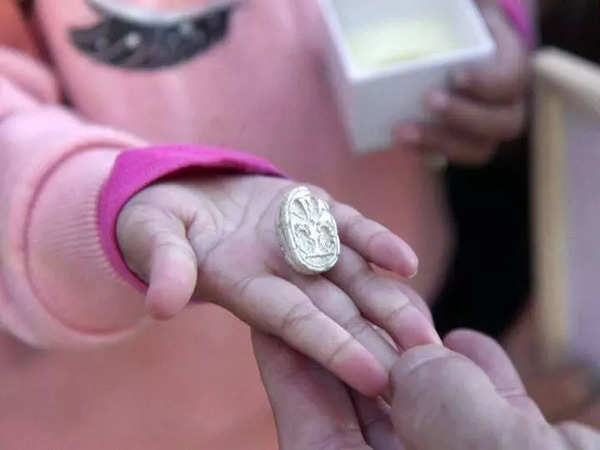Ancient Scarab Discovery: Toddler discovers 3,800-year-old Egyptian scarab amulet during family trip in Israel | – The Times of India

In early March, while on a family outing near Beit Shemesh at Tel Azekah, three-year-old Ziv Nitzan from Moshav Ramot Meir made an extraordinary, albeit accidental, discovery that would transport her and her family back in time by thousands of years. As Ziv walked along a seemingly ordinary path, she bent down to pick up what appeared to be just another stone. But after brushing off the sand, she revealed something far more significant, an ancient scarab amulet, dating back around 3,800 years.
“It was just another walk, nothing out of the ordinary,” recalled Ziv’s sister, Omer Nitzan. “But when Ziv picked up the stone, we realised something was different. It didn’t look like any stone we had ever seen before.” The family immediately alerted the Israel Antiquities Authority (IAA), who confirmed that they had found an artefact of immense historical value. The scarab, a symbol of both spiritual and social significance in the ancient world, would go on to be displayed in a special exhibition at the Jay and Jeanie Schottenstein National Campus for the Archaeology of Israel, alongside other rare items from Egypt and Canaan – many of which have never been publicly displayed before.

For the Nitzan family, it was a moment of unexpected history. Judah Region District Archaeologist Semyon Gendler commended them for their prompt action and even awarded little Ziv a certificate of appreciation for her contribution to preserving history. But for experts like Daphna Ben-Tor, an authority on ancient amulets and seals, the scarab represented something much deeper than a mere relic; it was a window into the intertwined cultures of Egypt and Canaan.
“Scarabs were incredibly important in the Middle Bronze Age,” explained Ben-Tor. “They were often used as seals and amulets and were found in graves, homes, and public buildings. Their symbolism went beyond simple decoration, they conveyed religious beliefs, social status, and personal identity.” The scarab, shaped like a dung beetle, was regarded in ancient Egypt as a symbol of creation, renewal, and the divine. It was believed to be a representation of the Creator God and had a powerful protective quality. Though originating in Egypt, scarabs eventually spread throughout the ancient world, becoming iconic symbols that bridged various cultures.
This particular scarab was discovered at the foot of Tel Azekah, a site famous for its archaeological richness. Known for its historical significance, Tel Azekah has yielded evidence of multiple civilisations, including remnants from the Judahite Kingdom. Excavations here have also uncovered structures dating back to the biblical period, with the site famously associated with the battle between David and Goliath, as recounted in the Book of Samuel. The discovery of Ziv’s scarab adds another layer to the growing collection of Egyptian and Canaanite artefacts found at the site, reinforcing the deep cultural connections between the two ancient civilisations.
Professor Oded Lipschits, director of the Tel Aviv University excavation at Tel Azekah, highlighted the importance of the scarab’s discovery. “The artefact further supports the notion that Egypt’s influence on Canaan was profound during the Middle and Late Bronze Ages,” he said. “It is a testament to the shared history and interactions between these two mighty ancient cultures.”
Israeli Heritage Minister Amichai Eliyahu marvelled at how such an important artefact was uncovered by a child. “This scarab is not only a link to ancient civilisations, but it also serves as a reminder that history is within reach for everyone, even the youngest among us.”
The scarab, along with other Egyptian artefacts, will be featured in a special Passover exhibition showcasing the deep-rooted cultural ties between Egypt and Israel. This unique exhibition will allow the public to appreciate ancient seals, ritual vessels, statues, and other items that underscore Egypt’s enduring influence on the Land of Israel.
Amulets: Ancient symbols of faith and fashion
The discovery of Ziv’s scarab reminds us that while amulets have always had deep spiritual and religious significance, they’ve also played a crucial role in fashioning personal identity and status. Throughout history, amulets were not just protective talismans but also fashionable accessories, proudly worn by the elite to signal their faith, wealth, and cultural standing.

In ancient Egypt, the scarab was one of the most iconic symbols. Carved from precious stones or metals, scarabs were often worn as jewellery, making them both a spiritual and fashionable accessory. Their symbolism -representing creation, rebirth, and divine protection – made them highly prized by Egyptians, who believed they could bring good fortune and ward off evil. These amulets were often worn as pendants, rings, or seals, serving not only as symbols of devotion but also as markers of social position.
As ancient Egyptian culture spread, so did the scarab. Canaanites, Greeks, and Romans adopted the beetle-shaped amulet, incorporating it into their own rituals and jewellery collections. In many cultures, amulets were worn as much for their aesthetic appeal as for their protective qualities. In fact, many individuals would wear these charms in prominent places, around their necks, wrists, or even as hair accessories – ensuring they were visible to others.
Today, the tradition of amulets continues, with modern jewellery designers often drawing inspiration from these ancient symbols. The scarab, in particular, has made its way into contemporary collections, proving that even in the world of high fashion, the combination of spirituality and style is as timeless as ever. Whether as a safeguard against misfortune or a statement piece, amulets remain a beautiful fusion of tradition, faith, and fashion, bridging the past and present.




